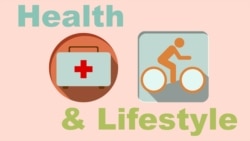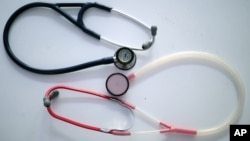Nearly every U.S. medical school gives new students a white coat and a stethoscope.
The act is part of a long tradition. But it is more than just symbolic. Medical schools still teach stethoscope skills. Doctors must be able to use them well to get their licenses.
But the stethoscope, 200 years after its invention, is facing an uncertain future.
New devices can help doctors find problems in the heart, lungs and other areas. They use ultrasound technology, artificial intelligence and smartphone apps.
Dr. Eric Topol is a world-renowned heart doctor. He considers the stethoscope obsolete – in other words, old and out of date. It “was OK for 200 years,” Topol said. But “we need to go beyond that. We can do better.”
Students at Indiana University, one of the nation’s largest medical schools, learn stethoscope skills. But they also get training in hand-held ultrasound technology. The training is part of a program launched there last year by Dr. Paul Wallach, one of the school’s leaders.
Five years ago, he created a similar program at the Medical College of Georgia. Wallach believes that within the next ten years, hand-held ultrasound devices will become part of the usual physical exam, just like the reflex hammer.
But Wallach added that he isn’t ready to declare the stethoscope dead. He believes younger doctors will be wearing “a stethoscope around the neck and an ultrasound in the pocket.”
Modern-day stethoscopes look different than the first stethoscope. It was invented in the early 1800s by Frenchman Rene Laennec. But the devices work in basically the same way. Sound waves make the device’s flat metal area shake. The shaking moves the sound through the tubes to the ears.
But hearing and understanding sounds from the human body requires a trained ear.
Dr. James Thomas is a heart doctor at Northwestern Medicine in Chicago. He says that with medical advances and competing devices, some younger doctors are not being trained well on the stethoscope. He notes recent studies that medical school graduates in some areas “may miss as many as half of murmurs using a stethoscope.”
There is, however, a large price difference between normal stethoscopes and high-tech devices. Stethoscopes usually cost under $200, compared with at least a few thousand dollars for some of the new devices.
Dr. Dave Drelicharz has been a doctor for children for more than 10 years. He understands the attraction of the newer devices. But, he says, until the price comes down, the stethoscope “is still your best tool.”
He said, “During my work hours in my office, if I don’t have it around my shoulders, it’s as though I was feeling almost naked.”
I’m John Russell.
Lindsey Tanner reported on this story for the Associated Press. John Russell adapted it for Learning English. Kelly Jean Kelly was the editor.
________________________________________________________________
Words in This Story
stethoscope – n. medical : an instrument that is used for listening to someone's heart or lungs
symbolic – adj. : expressing or representing an idea or quality without using words
ultrasound – n. medical : a method of producing images of the inside of the body by using a machine that produces sound waves which are too high to be heard
artificial (intelligence) – n. the power of a machine to copy intelligent human behavior
app – n. : a computer program that performs a special function
reflex hammer – n. a medical instrument used to test reflexes
pocket – n. a usually small cloth bag that is sewn into a piece of clothing, a larger bag, etc., and that is open at the top or side so that you can put things into it
murmur – n. medical : an unusual heart sound that may indicate a problem with the heart's function or structure
We want to hear from you. Write to us in the Comments Section.








